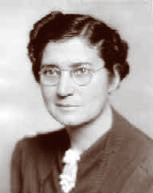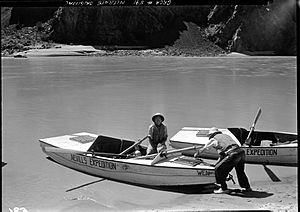Elzada Clover facts for kids
Quick facts for kids
Elzada U. Clover
|
|
|---|---|
 |
|
| Born | 12 September 1897 |
| Died | 2 November 1980 (aged 83) |
| Nationality | American |
| Citizenship | United States |
| Alma mater | Nebraska State Teachers College (1930) University of Michigan, Ann Arbor (1932; 1935) |
| Scientific career | |
| Fields | Botany |
| Institutions | University of Michigan |
Elzada Clover (1897–1980) was an amazing American botanist who loved studying plants. She made history by being the first person to create a list of all the plants found in the Grand Canyon along the Colorado River. Even more incredibly, she and her fellow botanist, Lois Jotter, were the first two women ever to raft through the entire Grand Canyon!
Contents
Early Life and Education
Elzada Urseba Clover was born in Auburn, Nebraska in 1897. She was the seventh of nine children in her family. Elzada grew up on her father's farm and went to high school in a nearby town called Peru.
She started her career as a public school teacher in 1919. She taught in Nebraska and later in Texas. Elzada also helped run a school for Native American children in Texas.
Elzada continued her own education, graduating from Nebraska State Teachers College in 1930. She then went to the University of Michigan, Ann Arbor. There, she earned her master's degree in 1932 and her Ph.D. (doctorate) in 1935. Her Ph.D. research was about the plants found in the lower Rio Grande Valley area.
A Career in Botany
After earning her Ph.D., Dr. Clover joined the University of Michigan as a botany instructor. Botany is the scientific study of plants. She also became the assistant curator of the university's botanical gardens. A curator is like a manager who takes care of a collection.
Over time, she became the curator of the botanical gardens in 1957. In 1960, she became a full professor of botany. This meant she was a top teacher and researcher. She also taught at the university's Biological Station in Pellston.
Studying Cacti and Succulents
Dr. Clover played a big part in setting up the cactus and succulent areas at the botanical gardens. Succulents are plants that store water in their leaves or stems, like cacti. She traveled a lot through the Southwest United States to find native plant species for the university's collection. She first focused on cacti from the Colorado Plateau in Utah.
In the late 1930s, she started planning a research trip down the Colorado River. Her goal was to list all the plants there. The university gave her money for the trip, hoping she would bring back many plant samples. She first thought about going by pack mule. But then she met Norman Nevills, a famous Colorado River boatman. They talked about going by boat instead.
Grand Canyon Expedition
In the 1930s, rafting through the Grand Canyon was very rare. A few men had done it safely. However, the only woman who had tried it before had not survived. When asked if the Grand Canyon trip was too dangerous for a woman, Dr. Clover bravely said: "Just because the only woman who ever attempted this trip was drowned is no reason women have any more to fear than men."
The Historic River Journey
The expedition led by Dr. Clover and Norman Nevills began in 1938. They traveled from Green River in Utah through the Cataract and Grand Canyons. Their journey ended at Lake Mead. The trip lasted 43 days and covered more than 600 miles! They used three special boats built by Nevills and his father: the Wen, the Botany, and the Mexican Hat.
During this amazing trip, Dr. Clover became the first botanist to list all the plant life along the river in the Grand Canyon. She and her graduate student, Lois Jotter, also became the first women to ever complete a river journey through the entire Grand Canyon. Other people on the trip included graduate student Eugene Atkinson, artist Bill Gibson (who took photos and film), and Don Harris, a geologist. Partway through the trip, Emery Kolb, a photographer, joined the group.
Discovering Grand Canyon Plants
Dr. Clover and Lois Jotter made lists of plants and collected samples throughout the trip. It was hard to keep the samples dry and safe in the boats. So, they ended up with fewer samples than they hoped.
They described the canyon as having five different plant zones. These zones ranged from the wet sand near the river to higher areas with shrubs and trees. Most of the plants they found were typical riverbank species. One exception was tamarisk, a plant that is not native to the area. They saw it in a few places. They also found very little snakeweed, which is now common in the canyon. Their plant survey is still important today. It is the only full study of the river's plant life from before the Glen Canyon Dam was built. After the trip, Dr. Clover and Jotter published their findings in a science magazine in 1944.
Later Expeditions and Legacy
Dr. Clover's next trip was to the San Juan River and in Texas. There, she collected fossil plant specimens. After that, she went to Havasupai Canyon in Arizona in 1939. She published her findings from these trips in a 1941 article with Lois Jotter. It was called "Cacti of the Colorado River and Tributaries."
In the years that followed, Dr. Clover focused her research on the deserts of Mexico and Guatemala. She also did some work in Haiti.
Dr. Clover was a member of several important science groups. These included the American Association for the Advancement of Science and the Botanical Society of America. She retired from the University of Michigan in 1967. She then moved to the Rio Grande Valley in Texas. She passed away in 1980. Her important papers and research notes are now kept at the Bentley Historical Library at the University of Michigan.
See also
 In Spanish: Elzada Clover para niños
In Spanish: Elzada Clover para niños


